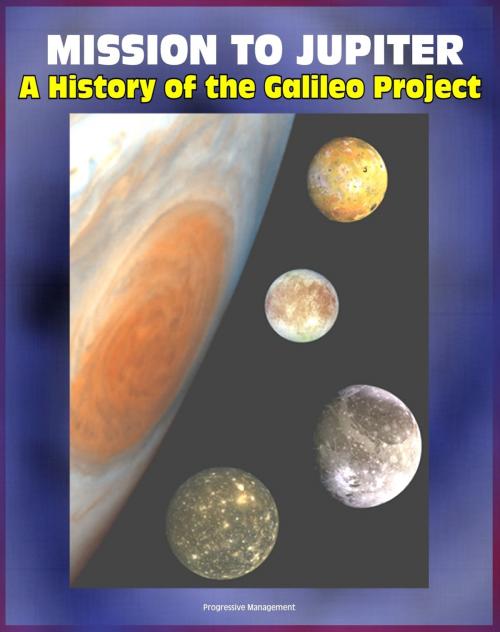Mission to Jupiter: A History of the Galileo Project - Comprehensive History of the Epic Exploration of Jupiter and its Moons, Io, Europa, Callisto, Failures and Triumphs (NASA SP-2007-4231)
Nonfiction, Science & Nature, Science, Physics, Astronomy, Astrophysics & Space Science| Author: | Progressive Management | ISBN: | 9781465915955 |
| Publisher: | Progressive Management | Publication: | January 20, 2012 |
| Imprint: | Smashwords Edition | Language: | English |
| Author: | Progressive Management |
| ISBN: | 9781465915955 |
| Publisher: | Progressive Management |
| Publication: | January 20, 2012 |
| Imprint: | Smashwords Edition |
| Language: | English |
This official NASA history document - converted for accurate flowing-text e-book format reproduction - is a comprehensive account of the epic Galileo probe of Jupiter and its moons, recounting the difficult path to launch, the change in Shuttle upper stages after the Challenger accident, the high gain antenna and tape recorder anomalies, and the enormous scientific success of the mission.
It details an extraordinary voyage of exploration, and highlights the trials, tribulations and triumphs in the long process required for success in planetary science. The Galileo spacecraft was launched Oct. 18, 1989, arrived at Jupiter on Dec. 7, 1995, and undertook its tour of Jupiter over the next two years.
This Prime Mission would have been quite enough to declare success, but it was followed by the Galileo Europa Mission, extending for two more years until December 1999. During this time the spacecraft studied not only studied Europa but also other Jovian satellites, especially (and appropriately) the other "Galilean satellites" discovered by Galileo almost 400 years before. Aside from satellites, the Galileo spacecraft would also study the magnetic fields, particles and atmosphere of Jupiter itself, notably with its releasable Atmospheric Probe. Even then, Galileo's explorations were not over; its lifetime was further extended by the Galileo Millennium Mission, which ran from January, 2000 through the end of mission operations in January 2003. Galileo's death occurred by design when it was sent on a collision course with Jupiter on Sept. 21, 2003 and burned up in Jupiter's dense atmosphere.
Galileo represented a new phase in the study of the outer planets. The Pioneer probes and Voyagers 1 and 2 together completed the preliminary reconnaissance of those gas giants. But Galileo undertook a much more systematic, in-depth, and holistic analysis of the entire Jupiter system, featuring close flybys of its satellites, and intense study of its particles and fields. And even before the spacecraft reached Jupiter it visited Venus, two asteroids, and twice returned to Earth, along the way observing a spectacular celestial crash.
The Galileo spacecraft and its Inertial Upper Stage booster rocket were deployed from the space shuttle Atlantis October 18, 1989. Shortly thereafter, the booster rocket fired and separated, sending Galileo on its six-year journey to the planet Jupiter. Upon its arrival at Jupiter in December 1995, Galileo released a probe into the atmosphere to survey the composition of the planet's clouds. The orbiter has relayed probe information, surveyed its surroundings, and photographed Jupiter and the Galilean satellites, among others.
Like many spacecraft, Galileo had an extended and painful birth. The total mission from launch to destruction lasted 14 years, but the "Jupiter Orbiter Probe" project from which it emerged had begun another 14 years before launch. Funding was won from Congress in 1977 and the project was renamed Galileo the following year. The spacecraft was originally scheduled to be deployed in 1984 aboard the Space Shuttle, which would not fly its first mission until April 1981. Once deployed in Earth orbit, the plan was for it to be launched by a Centaur upper stage toward Jupiter. Meanwhile, in the early 1980s the ever-watchful Office of Management and Budget proposed not only that Galileo should be cancelled, but that planetary exploration should be halted and JPL shut down. All three made it through that crisis, and in December 1985 the spacecraft was transported to the Kennedy Space Center for launch on the Shuttle Atlantis. But the Challenger tragedy in early 1986 ended the Centaur program, and new plans were devised using the solid-fueled IUS stage and a complicated slingshot trajectory.
This official NASA history document - converted for accurate flowing-text e-book format reproduction - is a comprehensive account of the epic Galileo probe of Jupiter and its moons, recounting the difficult path to launch, the change in Shuttle upper stages after the Challenger accident, the high gain antenna and tape recorder anomalies, and the enormous scientific success of the mission.
It details an extraordinary voyage of exploration, and highlights the trials, tribulations and triumphs in the long process required for success in planetary science. The Galileo spacecraft was launched Oct. 18, 1989, arrived at Jupiter on Dec. 7, 1995, and undertook its tour of Jupiter over the next two years.
This Prime Mission would have been quite enough to declare success, but it was followed by the Galileo Europa Mission, extending for two more years until December 1999. During this time the spacecraft studied not only studied Europa but also other Jovian satellites, especially (and appropriately) the other "Galilean satellites" discovered by Galileo almost 400 years before. Aside from satellites, the Galileo spacecraft would also study the magnetic fields, particles and atmosphere of Jupiter itself, notably with its releasable Atmospheric Probe. Even then, Galileo's explorations were not over; its lifetime was further extended by the Galileo Millennium Mission, which ran from January, 2000 through the end of mission operations in January 2003. Galileo's death occurred by design when it was sent on a collision course with Jupiter on Sept. 21, 2003 and burned up in Jupiter's dense atmosphere.
Galileo represented a new phase in the study of the outer planets. The Pioneer probes and Voyagers 1 and 2 together completed the preliminary reconnaissance of those gas giants. But Galileo undertook a much more systematic, in-depth, and holistic analysis of the entire Jupiter system, featuring close flybys of its satellites, and intense study of its particles and fields. And even before the spacecraft reached Jupiter it visited Venus, two asteroids, and twice returned to Earth, along the way observing a spectacular celestial crash.
The Galileo spacecraft and its Inertial Upper Stage booster rocket were deployed from the space shuttle Atlantis October 18, 1989. Shortly thereafter, the booster rocket fired and separated, sending Galileo on its six-year journey to the planet Jupiter. Upon its arrival at Jupiter in December 1995, Galileo released a probe into the atmosphere to survey the composition of the planet's clouds. The orbiter has relayed probe information, surveyed its surroundings, and photographed Jupiter and the Galilean satellites, among others.
Like many spacecraft, Galileo had an extended and painful birth. The total mission from launch to destruction lasted 14 years, but the "Jupiter Orbiter Probe" project from which it emerged had begun another 14 years before launch. Funding was won from Congress in 1977 and the project was renamed Galileo the following year. The spacecraft was originally scheduled to be deployed in 1984 aboard the Space Shuttle, which would not fly its first mission until April 1981. Once deployed in Earth orbit, the plan was for it to be launched by a Centaur upper stage toward Jupiter. Meanwhile, in the early 1980s the ever-watchful Office of Management and Budget proposed not only that Galileo should be cancelled, but that planetary exploration should be halted and JPL shut down. All three made it through that crisis, and in December 1985 the spacecraft was transported to the Kennedy Space Center for launch on the Shuttle Atlantis. But the Challenger tragedy in early 1986 ended the Centaur program, and new plans were devised using the solid-fueled IUS stage and a complicated slingshot trajectory.















